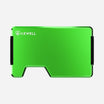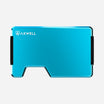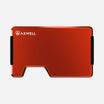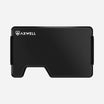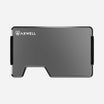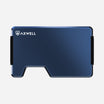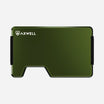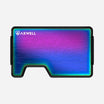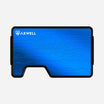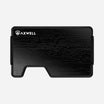The thrill of conquering a technical rock garden. The feeling of satisfaction when you get to camp and there’s no one to be seen for miles and miles around. Being filled with inner peace when you wake up with the sunrise and sipping on that first cup of morning coffee. These are some of the biggest benefits that you get when you start overlanding!
Overlanding is essentially like backpacking from your vehicle. You pack everything you need so you can be self-sufficient through your entire trip into your vehicle and set out on a trail to discover the great unknown of the backcountry! While some may argue that overlanding is just car camping, there is a big distinction between the two. Car camping is done in an established campground whereas overlanding is not. You have to find your campground and sometimes make it yourself! The discovery and adventure aspect is one of the biggest parts that sets overlanding apart from car camping.

If you’ve caught the overlanding bug or you’re just starting to feel it out, you’ve come to the right place. In this post we’ll discuss everything that you need to know in order to start overlanding as soon as possible. You’ll learn the most important things to getting started, such as:
- The type of vehicle you need
- The modifications you’ll want to make to your vehicle
- The types of trails you can take and how to find them
- The gear you’ll want to bring with you
- Safety tips and skills to keep you safe
Let’s get started.
1) Vehicle
The first thing you need to think about when getting into overlanding is your vehicle. Your vehicle is the center piece that you’ll build your setup around. It will get you to where you want to go and help you enjoy yourself when you get there.
There is a misconception that you need the top-of-the-line rock crawler to be an overlander. This couldn’t be further from the truth! When looking for an overlanding vehicle, you should consider where it is that you want to take it as well as how much stuff you want to bring with you.

Vehicles that are perfect for overlanding are usually 4x4 or all-wheel drive to ensure that you have plenty of power and traction to get through anything you encounter. The Toyota Tacoma and Jeep Wrangler are both excellent overlanding vehicles because they have plenty of storage space for all of your gear, they come with 4x4 as an optional feature, and they are easy to modify if you want to go further on more challenging trails!
The best thing to do is to just use the vehicle you have to get started. You don’t need anything fancy. Even if you have a front wheel drive car like a sedan or a station wagon, you can still go overlanding by exploring down a mellow forest service road! Just get started exploring with what you’ve got.
2) Vehicle Modifications
The next thing to do once you’ve selected a vehicle to build around is consider the modifications you want to make to your vehicle. Something to keep in mind here is that modifications can be as cheap or as expensive as you want them to be. There are tons of companies out there that produce all sorts of parts to modify vehicles for overlanding, so it’s really important to look into the reviews of their products before purchasing to make sure that you’re getting the best bang for your buck.
In terms of common modifications, you’re going to want to frame your wish list around the following and prioritize functionality over aesthetics, at first.
- Tires/wheels
- Lift kit for clearance
- Lighting
Your tires and wheels are the most important thing to upgrade on your vehicle. Getting a tire that is rated for all terrain or mud is best as those tires tend to have much better grip on their tread. That gives you the traction you need to crawl up any obstacle you encounter.

If you’re going overlanding where there are bigger rocks and berms to get up and over, you’ll also want to get your vehicle lifted. Most of the time, you won’t need much more than a 2- or 3-inch lift. If you start getting higher than that, you’ll end up spending a significant more amount of money as you’ll end up having to make more modifications to ensure that your vehicle gets enough power to the wheels after getting lifted higher than 3.5 inches.
Modifying your lights is another really important thing to do with an overlanding vehicle because you need to be able to see in the dark while driving. You may not plan on being on the trail in the dark, but part of overlanding is planning for the unexpected. Light bars, ditch lights, and improved fog lights are all great first steps to upgrading your vehicle’s light capability and will make an enormous difference when you’re driving in the dark.
3) Locating the Right Trail
Now that we’ve got the basics covered, it’s time to start looking for some trails to explore! The best thing that you can do is to begin looking at the national forest located closest to where you live. Get out and explore the forest service roads in your vehicle and start familiarizing yourself with what your vehicle is capable of doing.

Once you’re feeling pretty comfortable doing the easier trails, contact your forest’s ranger station and talk with the ranger about where they think you should explore next. The rangers are very familiar with the trails in their region, so they’re an expert opinion you can trust to have up to date information.
Another great idea for finding trails to overland on is to use a guide like those published by Charles Wells. He’s made several guidebooks that indicate the level of difficulty each trail in a given area is along with color photos to visualize where you’ll be going.
4) Gear
One of the best parts about overlanding is that you get to really flex your gear junkie muscles as there are so many things that you can bring with you to make your overlanding journey enjoyable. It can feel pretty overwhelming to figure out what you need to take. But, if you break down the gear you need to take into categories, you’ll be sure to bring exactly what you want and need to have with you in order to have a great time. These categories include:
Basic camping supplies- Tent
- Sleeping bag
- Sleeping pad
- Cooler
- Chairs
- Bug spray
- Games
- Flashlight
- First Aid Kit
- Water jugs
- Fire starting supplies

- Traction pads
- Tow straps
- Come-along or winch
- Extra gas
- Spare tire
- Hi jack & jack stand

Another big thing with your gear is to make sure you have it organized. As you add more stuff to your overlanding vehicle, you may find that you’re running out of space to store things inside of the vehicle. That’s where installing a roof rack comes in handy! Be careful to keep the stuff you store on the roof light and low, so that you don’t affect the balance of your vehicle too much. Having heavy gear stacked high on the roof will raise your vehicle’s center of gravity and may make it unstable, which is definitely not what you want to have happen when you’re driving through technical terrain!
Safety Tips
Overlanding offers the opportunity to get way the heck out there. You get the peace that comes with isolation. But you also get the dangers that come along with that isolation. In some cases, you can get to places where you won’t find another person for miles and miles! So you need to be smart and stay safe by following these safety tips.
- Always let someone know where you’re going and when you plan on being back.
- Try to travel with a friend so that they can help you if you get into trouble.
- Stay within the limits of your vehicle.
- Don’t be afraid to turn around.
- Check the weather before you go and consider replanning your trip if the weather is going to be really bad.
- Try to bring a cell phone, radio, or emergency locator beacon to contact someone if you do end up getting into trouble.

Emergencies happen all the time, so be smart and plan for the worst to happen by staying prepared and following these safety tips. The worst thing you can do is ignore the danger and think “that could never happen to me.” Respect the trail and the wilderness and you’ll be able to enjoy it for years and years to come.
Final Thoughts
Getting into overlanding can seem overwhelming at first, but if you break down each part of what you’ll need to know/do, it makes it much more approachable. And as you become more experienced and meet new overlanders, you’ll get more insight as to how to maximize your own set up and make it better each time you go out.
 Another thing to keep in mind is if you live an adventurous lifestyle, you need a wallet to keep up with it. Buying a new wallet every year can cost thousands of dollars over a lifetime. But like any quality-made product, the Axwell Wallet is an investment which pays off in the end. We’re so sure of that, that we confidently guarantee it for life.
Another thing to keep in mind is if you live an adventurous lifestyle, you need a wallet to keep up with it. Buying a new wallet every year can cost thousands of dollars over a lifetime. But like any quality-made product, the Axwell Wallet is an investment which pays off in the end. We’re so sure of that, that we confidently guarantee it for life.
Sign up for our Axwell Army Newsletter by clicking here and get a discount on your first purchase.

